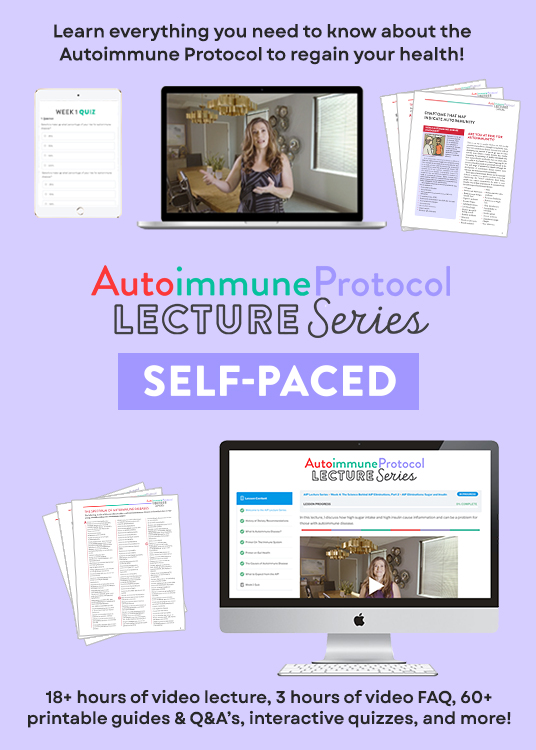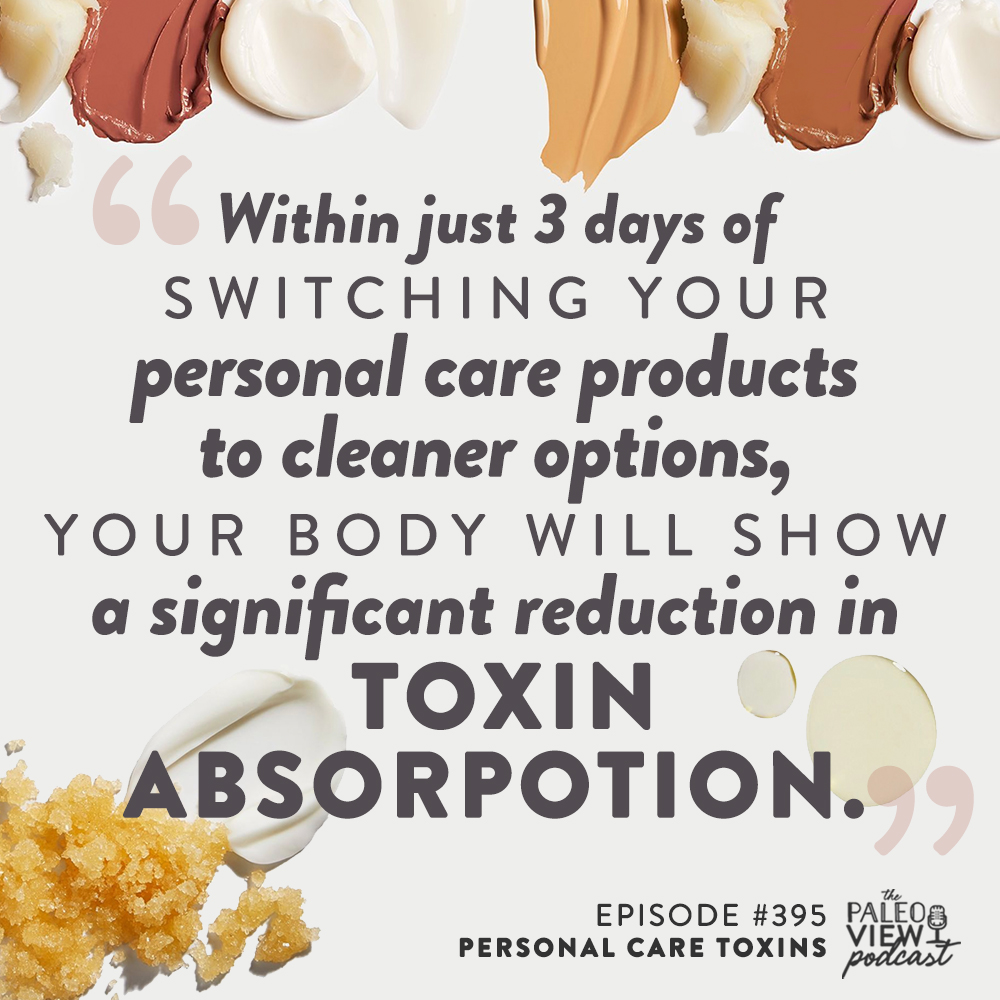On this week’s episode, Stacy and Sarah discuss the toxins that are hidden (often through mislabeling) in personal care products. Stacy breaks down ingredient lists and what to look for when making purchases and also shares information on how to advocate for transparency in the beauty industry. Enjoy!
If you enjoy the show, please review it on iTunes!
The Paleo View (TPV), Episode 395: Personal Care Toxins
Welcome to episode 395 of The Paleo View! (0:40)
It is opposite day again because Stacy has prepared a super detailed, science-backed, skincare follow up show.
Sarah once again gets to be the comic relief.
This episode is a follow up to the non-toxic skincare episode but will cover more than just skincare.
There has been a lot of information about toxins in general, and Stacy wants to dive into what this means.
This week Stacy is going to dive into gluten in personal care products, heavy metals in personal care, fragrances, asbestos, and more.
When discussing toxins, Stacy wants us to think about ‘is something actually poisonous’ or is it simply something that doesn’t work for you.
Like many things that are clickbait on the internet, you will find people saying things that are questionable.
This show will be science-based as Stacy and Sarah dive into what is actually toxic, poisonous, problematic things for you to use on your body and why.
Save 70% Off the AIP Lecture Series!
Learn everything you need to know about the Autoimmune Protocol to regain your health!
I am loving this AIP course and all the information I am receiving. The amount of work you have put into this is amazing and greatly, GREATLY, appreciated. Thank you so much. Taking this course gives me the knowledge I need to understand why my body is doing what it is doing and reinforces my determination to continue along this dietary path to heal it. Invaluable!
Carmen Maier

Sarah clarified how Stacy is defining the words toxic, sensitivity, healthy and safe.
Does Gluten in Skincare Matter?
The first thing Stacy is going to talk about is the thing that Stacy receives the most questions on, which is gluten in skincare. (4:31)
Even if there is gluten in a personal care product that would not make it toxic.
Something can still be non-toxic and natural and have gluten in it.
Ingredients and reading labels, just like with food, is going to be important in your personal care products.
How do you learn how to read the labels when looking for gluten?
It is important to understand that gluten-containing and derived from on a label are not the same thing.
You have some ingredients that are going to be ok for most people because they are not gluten-containing, even though they are derived from.
However, then you have a different class of ingredients that are inclusive of the protein, which is gluten.
So when you are thinking, “what do I need to look for?”, the questions that you need to be asking are as follows:
How sensitive to gluten are you?
Do you have a weekend immune system or gut dysbiosis?
Do you have an autoimmune condition?
Or skin that is weakened with open wounds?
More on Gluten Absorption
Our skin is a really good barrier and gluten protein, in particular, is too big for our skin to absorb.
So if you have healthy skin and you are not super sensitive (i.e. you don’t have celiac disease or an autoimmune disease), then using gluten in your skincare might actually be ok for you.
Sarah posed the question that it depends on how the product is derived and explained this in greater detail.
If you are someone who suspects a higher sensitivity, the potential for problems could be higher
When the structure of gluten changes, even if you are a healthy person, your skin would be absorbing it.
For Stacy, she does not touch hydrolyzed anything, even if it’s fermented.
Things that will impact your absorption of anything include steamed skin, dermabrasion, an open wound, and any sort of treatment to your skin like light treatment.
Be aware that when you do these treatments your skin is even more prone to absorb what is being applied topically. (12:50)
Stacy also avoids gluten-derived products for the mouth, the hands, or sprays, since you are absorbing these products via consumption.
It is not necessarily black or white.
It is more nuanced and up to personal needs and health history.
Ingredients to avoid include HYDROLYZED WHEAT PROTEIN, SECALE CEREALE (RYE) SEED EXTRACT, and HYDROLYZED HYALURONIC ACID.
Again, this is bio-individual and depends on the health of your skin.
Ingredients that Stacy feels comfortable including (after personally testing) are HYALURONIC ACID and SODIUM HYALURONATE, ARACHIDYL GLUCOSIDE, BETA-GLUCAN, SCLEROTIUM GUM, and SORBITOL.
The line of products that Stacy uses, BeautyCounter, does gluten testing on their products and are certified gluten-free.
Sarah mentioned that there is some concern in the medical community that the testing criteria for gluten-free is not rigid enough for celiacs.
The science on this hasn’t been clear enough to say what that guideline should be changed to, so there is still uncertainty around this.
If you are celiac or have severe gluten-sensitivity, utilizing a skin patch test is best.
Heavy Metals
A few years ago Stacy dove headfirst into the research that is available on heavy metal in personal care products. (24:15)
Again, this has all been heavily researched and what Stacy is going to share is backed by science.
Inhalation and ingestion of particular heavy metals are absorbed 120 times more than if it were put on your skin.
The most important thing that you need to switch over are things that you breathe or consume.
Sarah thinks it would be interesting to see how compromised skin would absorb toxins at an even greater amount.
Cadmium is a common heavy metal in personal care products that Stacy shared more about.
Its common route of entry is inhalation, ingestion, and absorption through the skin.
This commonly found toxin causes anemia, birth defects, impairment of pulmonary function, renal dysfunction, bone changes, liver damage (hepatotoxicity), kidney damage (nephrotoxicity), iron deficiency, oxidative stress.
Mercury
Mercury causes disruption of the nervous system, damage to brain functions, DNA damage and chromosomal damage, allergic reactions, tiredness and headaches, negative reproductive effects (sperm damage, birth defects, and miscarriages).
What gets to Stacy about personal care products is that a lot of them are linked to problems with infertility and reproductive health damage.
We find often that newborns, when their blood is tested when they come out of the womb, have high levels of ingredients and toxins in them.
Other Common Heavy Metals
Arsenic is absorbed through inhalation and ingestion, so not through the skin.
This heavy metal causes birth defects, carcinogen: lung, skin, liver, bladder, and kidneys, GI damage, severe vomiting, diarrhea, death.
Lead is a common one that most people think of when they think about toxins in beauty products.
It is regulated in the paint you put on your walls, but not in the lipstick you put on your mouth.
The last toxin that Stacy wants to mention is aluminum.
It is absorbed through inhalation, ingestion, and absorption through the skin
And aluminum can cause oxidative stress, aluminosis and dialysis encephalopathy syndrome, Alzheimer’s disease and breast cancer.
Using a natural or clean beauty brand does not mean that your product(s) are free of heavy metals.
It is very important to work with a brand that certifying or testing that their products do not contain heavy metals.
Heavy metals are by definition natural.
All of the points that Stacy raises make it abundantly clear that this industry needs to be regulated.
There need to be third-party testing laws and labeling laws.
Stacy forgot to mention that she is one of two representatives from Virginia who will get to go to DC to advocate for everyone to have means and access to safer personal care products.
In heavy metal toxicity, there are some studies out there.
One in particular that Stacy mentioned showed that exposure (even in low concentrations) causes a potential health risk to the user because they accumulate in the body over time.
Especially when people have specific conditions or a compromised immune system, they are more likely to see ill effects.
The Fragrances Loop Hole
There is absolutely no regulation that exists on what companies can or cannot put on the label of their products. (43:16)
Almost always paraben is a binder in fragrance, but products will use the label paraben-free since the paraben is technically in the fragrance.
For Stacy, if the word fragrance is anywhere on any label she doesn’t touch it.
The loophole allows companies to trick consumers by claiming that the full ingredients list is protected by trade secrets.
So companies are hiding ingredients claiming its fragrance.
Fragrance is more than just perfume.
It is most commonly found in household products.
In 2009 testing was done on Febreeze Air Effects and they detected 89 airborne contaminants that were not disclosed on the label.
There was a study done in the Journal of Air Quality Atmosphere and Health, which studied air pollution from laundry detergent.
The study determined that detergent was releasing carcinogens into the air.
Sarah noted that this also means that there are carcinogens in your clothes and on your skin at the end.
Companies may believe that exposure to these toxins in small doses isn’t going to hurt people.
However, we know for a fact that it has been determined for many of these toxins that no small amount of exposure is safe.
If you were only getting exposed to a small amount maybe it wouldn’t be toxic and your body would detoxify.
But these toxins are all around us and we are not absorbing them in small amounts.
The average woman puts 14 personal care products on her person a day.
So when you think about how many ingredients are in those products and how they are amplified in the system with our laundry products and household cleaning products, our bodies cannot detoxify this load.
We as consumers have to research the brands we are choosing to use and understand their integrity.
Talc & Asbestos
There is a documentary out that released in December 2019 called Toxic Beauty. (53:05)
Stacy is all for education, but because there were specific FDA recalls that happened and specific talking points were shared on talc it caused widespread panic.
Unless the brand you use CERTIFIES their talc is asbestos-free, avoid it.
Saying “talc causes cancer” isn’t correct.
We need to be careful what we say because when we are factually incorrect we lose credibility.
Instead, we say: Talc can be contaminated with asbestos, a known carcinogen.
EWG just did another test, less than a month ago, and found more asbestos, which you can read more about here.
Stacy put this higher absorption into perspective.
Within just three days of switching your personal care products to cleaner options, you are able to show a significant reduction in the toxins found in your body.
This makes a huge difference in teens whose hormones are still sensitive.
Make sure that you are using a brand that continually tests.
Closing Thoughts
The first step is to be an informed consumer.
The second piece is to be an advocate for safer options.
You can text ‘BETTERBEAUTY’ to 52886.
A form letter will be auto-populated for you, and then you can edit it to make it more personal.
The more personal the letter is, the better.
There are two bills in the house related to better beauty, and Stacy described these in greater detail.
There is a division within BeautyCounter that is dedicated to advocacy.
It isn’t tied to their brand, it is part of what they use their profits for because they want everyone to have access to safe products.
They are hoping to expose the mica industry because it is abused on ingredient lists.
There is a campaign to ask your lawmakers to look into enforcing the fairtrade and lack of child labor into the mic industry.
You can text ‘MICA’ to 52886 to help with this.
Continuing to support Stacy through BeautyCounter allows them to better lobby for these changes.
BeautyCounter is working to help other safe brands.
We have to be a voice as consumers and speak up to demand protection.
If you have any follow up questions about toxins or personal care product ingredients feel free to email Stacy or reach out to her on social media.
Additional Resources:
Sarah thanked Stacy for all the research she did for this episode.
She thinks this will be an awesome resource for listeners.
Don’t forget to support the show by leaving a review wherever you listen to this podcast.
Or tell someone about the show and share a favorite episode with them.
Thanks for listening!
Stacy and Sarah will be back again next week! (1:07:17)










